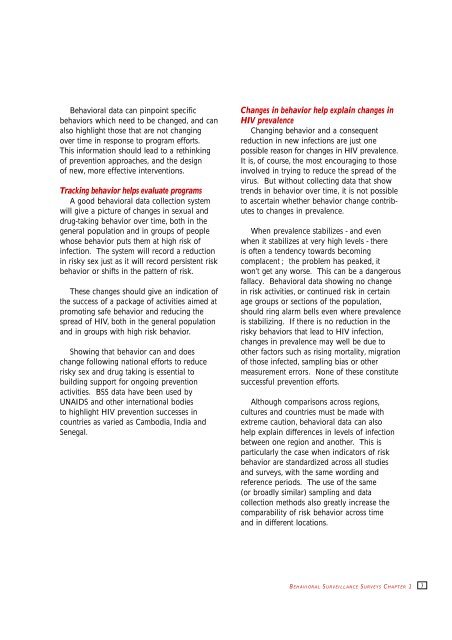Behavioural Surveillance Surveys - The Wisdom of Whores
Behavioural Surveillance Surveys - The Wisdom of Whores
Behavioural Surveillance Surveys - The Wisdom of Whores
You also want an ePaper? Increase the reach of your titles
YUMPU automatically turns print PDFs into web optimized ePapers that Google loves.
Behavioral data can pinpoint specific<br />
behaviors which need to be changed, and can<br />
also highlight those that are not changing<br />
over time in response to program efforts.<br />
This information should lead to a rethinking<br />
<strong>of</strong> prevention approaches, and the design<br />
<strong>of</strong> new, more effective interventions.<br />
Tracking behavior helps evaluate programs<br />
A good behavioral data collection system<br />
will give a picture <strong>of</strong> changes in sexual and<br />
drug-taking behavior over time, both in the<br />
general population and in groups <strong>of</strong> people<br />
whose behavior puts them at high risk <strong>of</strong><br />
infection. <strong>The</strong> system will record a reduction<br />
in risky sex just as it will record persistent risk<br />
behavior or shifts in the pattern <strong>of</strong> risk.<br />
<strong>The</strong>se changes should give an indication <strong>of</strong><br />
the success <strong>of</strong> a package <strong>of</strong> activities aimed at<br />
promoting safe behavior and reducing the<br />
spread <strong>of</strong> HIV, both in the general population<br />
and in groups with high risk behavior.<br />
Showing that behavior can and does<br />
change following national efforts to reduce<br />
risky sex and drug taking is essential to<br />
building support for ongoing prevention<br />
activities. BSS data have been used by<br />
UNAIDS and other international bodies<br />
to highlight HIV prevention successes in<br />
countries as varied as Cambodia, India and<br />
Senegal.<br />
Changes in behavior help explain changes in<br />
HIV prevalence<br />
Changing behavior and a consequent<br />
reduction in new infections are just one<br />
possible reason for changes in HIV prevalence.<br />
It is, <strong>of</strong> course, the most encouraging to those<br />
involved in trying to reduce the spread <strong>of</strong> the<br />
virus. But without collecting data that show<br />
trends in behavior over time, it is not possible<br />
to ascertain whether behavior change contributes<br />
to changes in prevalence.<br />
When prevalence stabilizes - and even<br />
when it stabilizes at very high levels - there<br />
is <strong>of</strong>ten a tendency towards becoming<br />
complacent ; the problem has peaked, it<br />
won’t get any worse. This can be a dangerous<br />
fallacy. Behavioral data showing no change<br />
in risk activities, or continued risk in certain<br />
age groups or sections <strong>of</strong> the population,<br />
should ring alarm bells even where prevalence<br />
is stabilizing. If there is no reduction in the<br />
risky behaviors that lead to HIV infection,<br />
changes in prevalence may well be due to<br />
other factors such as rising mortality, migration<br />
<strong>of</strong> those infected, sampling bias or other<br />
measurement errors. None <strong>of</strong> these constitute<br />
successful prevention efforts.<br />
Although comparisons across regions,<br />
cultures and countries must be made with<br />
extreme caution, behavioral data can also<br />
help explain differences in levels <strong>of</strong> infection<br />
between one region and another. This is<br />
particularly the case when indicators <strong>of</strong> risk<br />
behavior are standardized across all studies<br />
and surveys, with the same wording and<br />
reference periods. <strong>The</strong> use <strong>of</strong> the same<br />
(or broadly similar) sampling and data<br />
collection methods also greatly increase the<br />
comparability <strong>of</strong> risk behavior across time<br />
and in different locations.<br />
B EHAV I OR A L S U R V EI L L A NC E SURV EY S CHAPTER 1<br />
3










